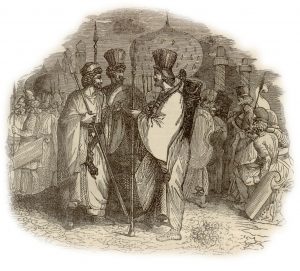 Next week the Jewish holiday of Purim is celebrated and then about a week later the Persian holiday of Nowruz. In this week’s blog post I’ll share with you the intriguing Biblical history which links these two ancient holidays to a period of time nearly 2500 years ago when an evil man set out to destroy the Jewish people.
Next week the Jewish holiday of Purim is celebrated and then about a week later the Persian holiday of Nowruz. In this week’s blog post I’ll share with you the intriguing Biblical history which links these two ancient holidays to a period of time nearly 2500 years ago when an evil man set out to destroy the Jewish people.
This story begins with an April fool named Haman. I’ll get to the April fool part a bit later, but in any case Haman was a man of great influence during the reign of a Persian king Artaxerxes. But Haman had a problem. He hated Jews. Now hate is a self-destructive problem for anyone, but when that hate is directed at a particular group of people that YHWH, the living God of the Bible, made an eternal covenant with, then that hate is sure to be the undoing of its bearer.
Haman’s story, at least for the purpose of this article begins in the Persian New Year during the celebration of Nowruz. Nowruz, literally “new light” is the name of the Persian new year celebration which lasts twelve days. It is celebrated in the spring and is closely related to the Spring Equinox. Historians say it has been celebrated for at least 3000 years. Today these twelve days are a joyous time of visiting family and friends but then there is the 13th day…
You see on the 13th day of the New Year, the Persian people celebrate Sizdah-bedar. Sizdah-bedar literally means getting rid of or getting past 13. It is often associated with bad luck and ill omen and is one of the earliest known examples of triskaidekaphobia (fear of the number 13).
Today many Persian families spend the day in the countryside. It is so widely celebrated that some towns seem deserted on the day. This tradition can be traced as far back as the 6th century BC. and it is celebrated not just in Iran but Iraq, Azerbaijan, Central Asia, and Armenia. On this day Persians play practical jokes on each other and some claim it is the basis for our modern April Fool’s day. It is interesting to note that Sizdah-bedar is strangely absent from much of Persian history after it became part of the Muslim world in the seventh century.
Intriguingly about the same time Sizdah-bedar is first noticed historically in Persian culture, the very same day is recorded as a day of infamy in Biblical tradition. In the book of Esther, our infamous Haman conceives a plan to destroy the Jewish people. As part of his preparations he starts casting Pur (lots) in the 1st month of the 12th year of the Persian king Ahasuerus.(The first month = Nisan, which is the equivalent of the Persian Nowruz)
 Haman continues with this ritual for 12 months. Then in the 1st month (13th month from when it began), in the 13th year of king Ahasuerus, on the 13th day of the month the king gives Haman his official blessing to destroy all the Jews in the kingdom Persia, Haman’s diabolical plan becomes law. This evil day was Sizdah-bedar, the very same day which Persians for the last 2500 years have associated with bad luck and ill omen.
Haman continues with this ritual for 12 months. Then in the 1st month (13th month from when it began), in the 13th year of king Ahasuerus, on the 13th day of the month the king gives Haman his official blessing to destroy all the Jews in the kingdom Persia, Haman’s diabolical plan becomes law. This evil day was Sizdah-bedar, the very same day which Persians for the last 2500 years have associated with bad luck and ill omen.
But as we all know, Haman chose the wrong group of people to mess with. YHWH rose up a courageous young women named Esther (Hadassah) to foil Haman’s evil machinations. It was through Esther as the Queen of Persia that a day meant for the destruction of the Jewish people instead became the means by which the Jewish people triumphed over their enemies. For over 2500 years now the 13th, 14th, & 15th of Adar is remembered as a day of deliverance for the Jewish people in their celebration of Purim. But now you know the rest of the story.
In closing I can’t help but think it is strangely ironic, that Sizdah-bedar, the day of getting rid of 13, was the day Haman was given permission to “get rid” of a nation of people who it could be argued consisted of 13 tribes. But it turns out the joke was on him. April fools indeed!
A couple lessons to be learned from this story:
- Don’t let hate take hold in your life because it will destroy you.
- And don’t make evil plans for the Jewish people, because YHWH made promises to them He intendeds to keep.
The lot is cast into the lap; but the whole disposing thereof is of YHWH. (Proverbs 16:33)
* * *



